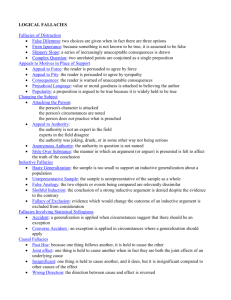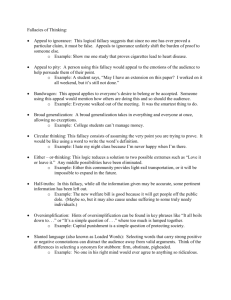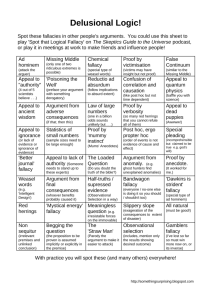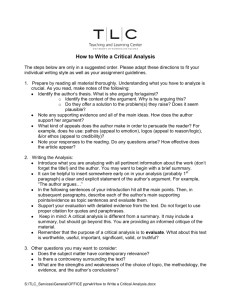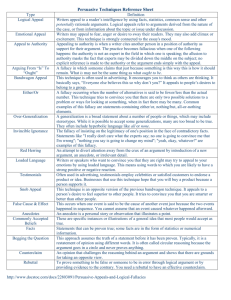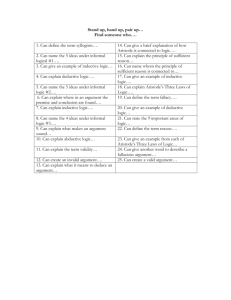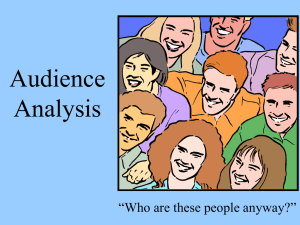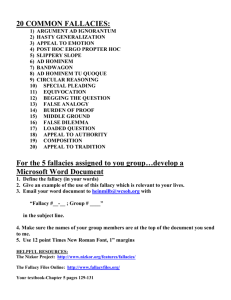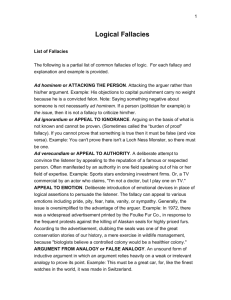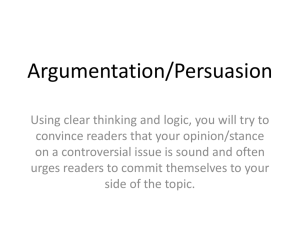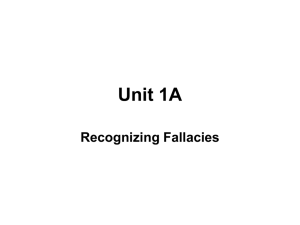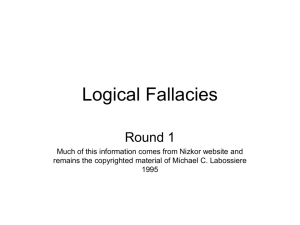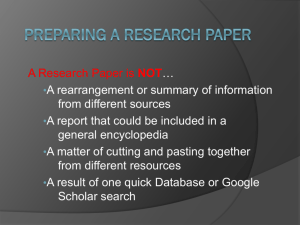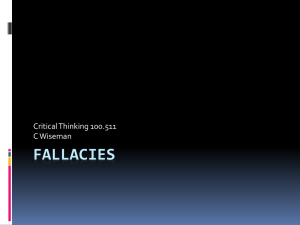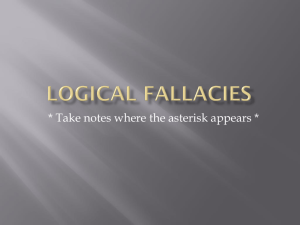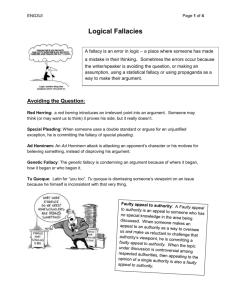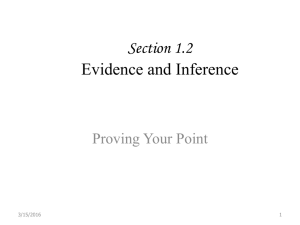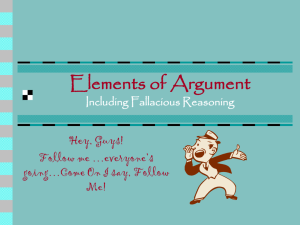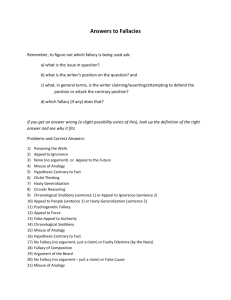1 - Kyoo Lee
advertisement
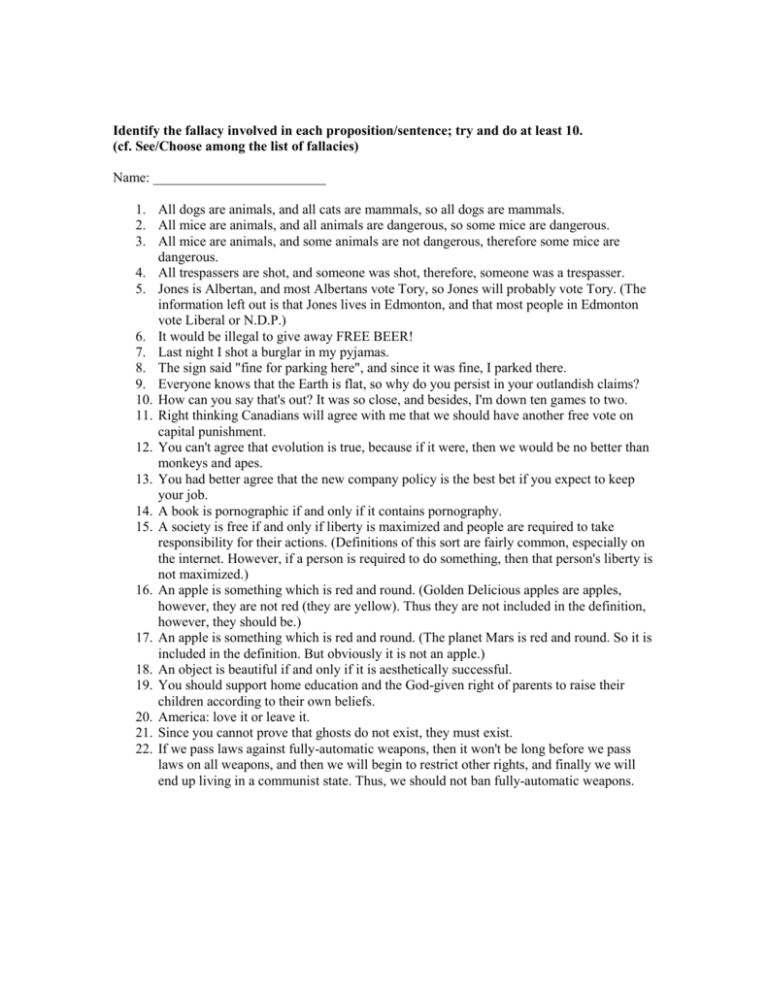
Identify the fallacy involved in each proposition/sentence; try and do at least 10. (cf. See/Choose among the list of fallacies) Name: _________________________ 1. All dogs are animals, and all cats are mammals, so all dogs are mammals. 2. All mice are animals, and all animals are dangerous, so some mice are dangerous. 3. All mice are animals, and some animals are not dangerous, therefore some mice are dangerous. 4. All trespassers are shot, and someone was shot, therefore, someone was a trespasser. 5. Jones is Albertan, and most Albertans vote Tory, so Jones will probably vote Tory. (The information left out is that Jones lives in Edmonton, and that most people in Edmonton vote Liberal or N.D.P.) 6. It would be illegal to give away FREE BEER! 7. Last night I shot a burglar in my pyjamas. 8. The sign said "fine for parking here", and since it was fine, I parked there. 9. Everyone knows that the Earth is flat, so why do you persist in your outlandish claims? 10. How can you say that's out? It was so close, and besides, I'm down ten games to two. 11. Right thinking Canadians will agree with me that we should have another free vote on capital punishment. 12. You can't agree that evolution is true, because if it were, then we would be no better than monkeys and apes. 13. You had better agree that the new company policy is the best bet if you expect to keep your job. 14. A book is pornographic if and only if it contains pornography. 15. A society is free if and only if liberty is maximized and people are required to take responsibility for their actions. (Definitions of this sort are fairly common, especially on the internet. However, if a person is required to do something, then that person's liberty is not maximized.) 16. An apple is something which is red and round. (Golden Delicious apples are apples, however, they are not red (they are yellow). Thus they are not included in the definition, however, they should be.) 17. An apple is something which is red and round. (The planet Mars is red and round. So it is included in the definition. But obviously it is not an apple.) 18. An object is beautiful if and only if it is aesthetically successful. 19. You should support home education and the God-given right of parents to raise their children according to their own beliefs. 20. America: love it or leave it. 21. Since you cannot prove that ghosts do not exist, they must exist. 22. If we pass laws against fully-automatic weapons, then it won't be long before we pass laws on all weapons, and then we will begin to restrict other rights, and finally we will end up living in a communist state. Thus, we should not ban fully-automatic weapons. <List of Fallacies> 1. Accent: the emphasis on a word or phrase suggests a meaning contrary to what the sentence actually says 2. Accident: a generalization is applied when circumstances suggest that there should be an exception 3. Affirming the Consequent: any argument of the form: If A then B, B, therefore A 4. Amphiboly: the structure of a sentence allows two different interpretations 5. Appeal to Authority 6. Appeal to Authority; Anonymous 7. Appeal to Force: the reader is persuaded to agree by force 8. Appeal to Pity: the reader is persuaded to agree by sympathy 9. Attacking the Person 10. Begging the Question: the truth of the conclusion is assumed by the premises 11. Circular Definition (The definition includes the term being defined as a part of the definition) 12. Complex Question: two unrelated points are conjoined as a single proposition 13. Conflicting Conditions (The definition is self-contradictory) 14. Consequences: the reader is warned of unacceptable consequences 15. Converse Accident : an exception is applied in circumstances where a generalization should apply 16. Denying the Antecedent: any argument of the form: If A then B, Not A, thus Not B 17. Equivocation: the same term is used with two different meanings 18. Existential Fallacy: a particular conclusion is drawn from universal premises 19. Failure to Elucidate (The definition is more difficult to understand than the word or concept being defined) 20. Fallacy of Drawing an Affirmative Conclusion From a Negative Premise: as the name implies 21. Fallacy of Exclusion: evidence which would change the outcome of an inductive argument is excluded from consideration 22. Fallacy of Exclusive Premises: a syllogism has two negative premises 23. Fallacy of Four Terms: a syllogism has four terms 24. False Analogy: the two objects or events being compared are relevantly dissimilar 25. False Dilemma: two choices are given when in fact there are three options 26. From Ignorance: because something is not known to be true, it is assumed to be false 27. Hasty Generalization: the sample is too small to support an inductive generalization about a population 28. Inconsistency: asserting that contrary or contradictory statements are both true 29. Irrelevant Conclusion: an argument in defense of one conclusion instead proves a different conclusion 30. Limited Depth (The theory which explains does not appeal to underlying causes 31. Limited Scope (The theory which explains can only explain one thing) 32. Non-support (Evidence for the phenomenon being explained is biased) 33. Popularity: a proposition is argued to be true because it is widely held to be true 34. Prejudicial Language: value or moral goodness is attached to believing the author 35. Slippery Slope: a series of increasingly unacceptable consequences is drawn 36. Slothful Induction: the conclusion of a strong inductive argument is denied despite the evidence to the contrary 37. Straw Man: the author attacks an argument different from (and weaker than) the opposition's best argument 38. Style over substance 39. Subverted Support (The phenomenon being explained doesn't exist) 40. Too Broad (The definition includes items which should not be included) 41. Too Narrow (The definition does not include all the items which shouls be included) 42. Undistributed Middle: two separate categories are said to be connected because they share a common property 43. Unrepresentative Sample: the sample is unrepresentative of the sample as a whole 44. Untestability (The theory which explains cannot be tested)
